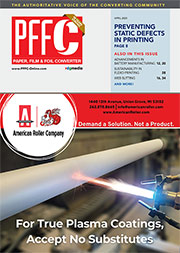Featured Stories
-
Advantages of Shear, Razor and Crush Web Slitting Techniques
When choosing a slitting method, many factors must be considered, including interaction with inspection systems. -
Revolutionizing Lithium-lon Battery Manufacturing Advances in Slot-Die and Electrode Coating Technology
As the global battery market surges toward an estimated $328 billion by 2028, innovations in manufacturing processes are becoming increasingly... -
Nordson Divisions Collaborate to Achieve Unprecedented Flat Profile Time
Nordson Measurement & Control Solutions (a division of Nordson Corporation) is a global leading provider of gauging systems for the film...
News | New Products
-
Morris Packaging to Add New KY Flex-pack Plant
Bloomington, IL-based Morris Packaging plans to build a new $60.9-million production plant in Marion County (KY), a project that will create 276 full-time jobs.
-
Press Belt Manufacturer IPCO to Focus on Engineering and Service Expertise
IPCO will use Ligna 2025 to highlight the service and support services it provides to press manufacturers and WBP producers alike.
-
INX promotes seven Executives to Vice President positions
INX International Ink Co. has announced the Board of Directors has approved the promotions of seven key people to Vice President positions.
-
Bimec and Flex CA Strengthen U.S. Market Presence with a new installation at Cello-Wrap Packaging Inc.
Bimec and Flex CA proudly announce a new milestone in their U.S. market expansion with the recent commissioning of a state-of-the-art slitter rewinder at Cello-Wrap Packaging Inc, located in Farmersville - TX.
-
New Era Converting promotes industry veteran Stephen Pickett to controls engineering manager
New Era Converting, an IPCO company, has announced that Stephen Pickett is taking on a new role as controls engineering manager.
-
Fedrigoni Announces New Slitting Center for Self-Adhesive Labels in Germany in Q4 2025
The Fedrigoni Group - a world reference in the manufacturing of self-adhesive labels, special papers for packaging and other creative applications, graphic supports for visual communication and RFID
-
Advancing Label Innovation Through Collaboration
Packaging is a physical representation of a brand’s identity, and label converters play an essential role in bringing the packaging experience to life.
Expert Advice
PFFC Worldwide Special Report on Release Liners, part 2
- Published: October 31, 2004
Part 1 | Part 2
Response to Rising Platinum Prices
Loretta Jones, associate industry scientist, Dow Corning Corp., Midland, MI, covers a release coating system with low levels of platinum.
Of the nearly 27 billion sq m of release liners and films coated globally each year, more than 80% utilize silicone release coatings catalyzed by platinum. It can convert a coating from a pourable liquid to a hard rubber film in little more than a second, and release liners made with platinum-cured silicone chemistry require minimal post-cure and exhibit no reversion. Unfortunately, increasing global demand for platinum in other industries has caused prices to rise sharply.
A low-platinum, cost-control solution that does not require users to compromise processing or release performance has been developed. This solventless, platinum-catalyzed, thermal-cure release coating system features new base polymers and crosslinkers with proprietary architectures, plus a choice of release modifiers and catalysts. Two inhibitor choices meet differing needs for low-temperature cure vs. longer thin-film bath stability.
Significantly lower platinum usage is possible: 20–50 ppm vs. the 100 ppm or more that conventional systems require. In many high-volume applications, this can result in a 10%–15% savings in silicone costs—without compromising on important processing and performance parameters such as bath life, anchorage, line speed, or release stability to realize this cost savings.
Processing Parameters
The proprietary crosslinker architecture enables excellent cure with very low levels of platinum.
At a platinum level of 50 ppm, both inhibitor systems provide bath life performance of at least 6 hrs before viscosity doubles. Current mixing systems that provide accurate delivery on either a batch or continuous basis can be used, but are not required, to manage bath life. Typically, a simple reduction of the platinum catalyst level in standard formulations can compromise anchorage performance.
An additional characteristic of this new polymer is flatter release profiles across the peel speed range, while the availability of release modifiers allows coaters to tailor the release profile to their end-use requirements.
In customer trials, there has been increased cure performance with very low platinum requirements, and further along the value chain, converters have achieved faster stripping speeds due to flatter release profiles. While some traditional polymers also provide flat release profiles, they do not combine the fast cure realized during liner or laminate production with the faster converting performance the new polymers provide.
For more information visit dowcorning.com.
Developing a Calibration Tape
Adrian deKrom, R&D manager at Chemsultants Intl., Mentor, OH, discusses the use of a calibration tape to detect testing errors.
The need for certified standards for physical and chemical testing and analysis has been recognized since ancient times. Today there are many internationally accepted standards used to validate testing methodologies and increase confidence in test results.
Measurement of Pressure-Sensitives
Pressure-sensitive adhesive products often are sold with certificates of analysis indicating they conform to a specification. Testing equipment used for measuring physical properties of p-s adhesives measure adhesion forces through a device known as a load cell. Load cells require periodic calibration to ensure the device is accurate. The accuracy is determined through the use of calibrated weights. It is essential the test equipment is properly calibrated or that the calibration is verified prior to testing.
Calibration or verification alone will not guarantee the accuracy and precision of the p-s adhesive’s property measurements: other factors affecting accuracy and precision are material conditioning and environmental control of temperature and humidity. Test panel condition, cleaning, and preparation also are important. Finally, it is critical that proper test methods are followed in addition to best practices. ASTM, the Tag and Label Mfr. Inst. (TLMI), and the Pressure Sensitive Tape Council (PSTC) are good sources of information on test methods.
Even when proper methodologies are followed, minor errors can occur. Sometimes precision can be good but accuracy poor. This is dangerous because the errors are not likely to be detected. To minimize the likelihood of this situation occurring, labs must conduct proficiency testing to determine interlab precision and accuracy.
QA and R&D labs are under pressure to be as productive as possible: time spent on proficiency and testing often is delayed or eliminated in lieu of urgent demands, although the accuracy of results is as important as ever.
To ensure competency, technicians must be certified for running each individual test. Proficiency testing should be performed annually to ensure each technician is competent in running each test according to ASTM, TLMI, or PSTC test methods.
The Role of a Certified Calibration Tape
It would be useful to have a means of evaluating the accuracy of critical tests in a short period of time, which leads to the need for a certified calibration tape to be used as a tool in ensuring accurate test results. Labs at Chemsultants Intl. wanted to verify the feasibility of developing a certified calibration tape, stable for a specified length of time and tested according to appropriate industrywide methods. Testing would need to be conducted by technicians certified for each test method and employing best-practices methods.
The purpose of a calibration tape is different from that of standard tapes. Examples of tapes typically used in the p-s industry as standards are 3M 610 tape and tesa 7475. The 3M tape typically is used to gauge ink anchorage, and the tesa tape typically is used to gauge release properties. Although these tapes are stable and consistent products, they are not certified. In order to be used for the function described above, the tape must be certified.
To perform properly, a calibration tape must be produced with stable components. In our study, we chose high-grade polyester film for the facestock and release liner. We selected a well-cured release system and chose an acrylic adhesive in which the crosslink density could be controlled. For consistency, we opted for full cure.
Test panel preparation is critical for good reproducibility. Therefore, we selected stainless steel panels in excellent condition and cleaned them according to the ASTM D2651 specification for surface cleanliness. Environmental conditions in the laboratory were closely monitored to ensure proper testing conditions for temperature and humidity were maintained throughout the study.
The concept of a calibration tape is to provide a simulated round-robin testing tool to any facility, without having to employ additional labs to test simultaneously. As such, the calibration tape would need to be certified for selected tests, with accuracy and precision being measured. Each test lot would be certified individually.
Certifications include width, thickness, peel adhesion, loop tack, release, and shear measurements. Gauge repeatability and reproducibility analysis, derived from round-robin studies, will serve as the basis for determining the acceptable range around the mean value.
First Results
To date, testing runs in our A2LA-accredited lab have generated reasonable results. We have additional work to complete related to beta site testing and validation of these results. Based upon current data, it appears the calibration tape is capable of identifying lab-to-lab variability in test results. Appropriate ranges must be established to determine when a testing laboratory is outside the acceptable range, along with a protocol for resolving the issue. Once accomplished, the use of a calibration tape will allow for early detection of testing errors and lead to savings in time and material.
Part 1 | Part 2













